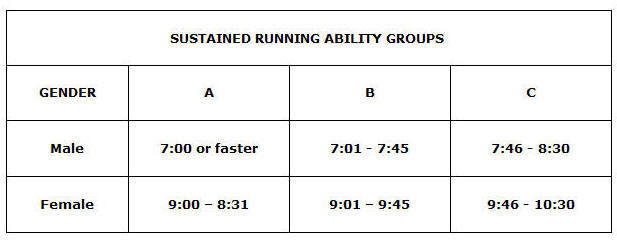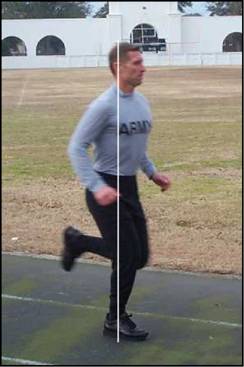Running (Cardio-Respiratory Endurance Training - CR)
SECTION III
RUNNING
(Cardio-respiratory Endurance Training)
Cardio-respiratory endurance refers to your body’s ability to utilize oxygen in the working muscles. IMT will challenge your cardio-respiratory endurance in activities such as: ability group runs, speed running, foot marching, obstacle and bayonet assault course negotiation, and during daily activities that involve common skills training.
Getting Started
You and your recruiter will review the results of the one-mile run event on the 1-1-1 Physical Fitness Assessment. Your one-mile run time will be used to determine your placement in either the Walk-to-Run Program or one of the three running ability groups (A, B or C). Your recruiter will inform you of which training schedule to follow and which running ability group to which you will be assigned (Refer to Appendix E). When beginning a running program, care should be taken to follow a proper progression for both intensity and duration. Cardio-respiratory training, particularly running, if begun without proper preparation can contribute to lower extremity injuries. Improvements in your body’s ability to use oxygen occur when exercise involves the use of large muscle groups over extended periods in activities that are rhythmic and aerobic in nature (e.g. running, walking, swimming, cycling, and some recreational sports). Walking or running may be the activity of choice because it is readily accessible and can be performed any time or place with little or no training.
Walk-to-Run Program
If you are a male and your 1-mile time was slower than 8:30 or a female and your 1-mile time was slower than 10:30 on the 1-1-1 Physical Fitness Assessment, begin with this section. When new runners or runners of lower fitness levels start a running program, they often follow a walk-run progression. During the first four weeks you will alternate walking and running for the time listed on the training schedule and repeat the walk-run routine five times in each training session. You will gradually decrease the walk time and increase the run times over the four weeks. When you have completed the walk-to-run program you are now ready to progress to the next stage of your training. The run progression starts at week 5 of your designated training schedule. You should run continuously for the time period listed on the training schedule. You should run at a pace that you are able to maintain for the entire time listed. You should not feel out of breath during the runs. If you are able to carry on a conversation as you run (the talk test), then you are probably running at the right pace. Resist the temptation to run longer than the time specified on your training schedule. The program will get harder; it is designed to gradually and safely increase your endurance. During weeks 7 through 12 you will run one mile at a designated pace that progresses each week to enable you to meet the BCT standard. You will also add speed running to the program, which will increase the intensity and help you to run faster. Make sure that you properly warm-up with the standardized
warm-up before the walk-run activity and properly cool-down with the standardized cool-down after the walk-run activity. Refer to the training schedules in Appendix E.
Sustained Running
If you are a male and your 1-mile time was 8:30 or faster or a female and your 1-mile time was 10:30 or faster on the 1-1-1 Physical Fitness Assessment begin with this section. Run continuously for the time period, at the designated pace listed for your gender and ability group, on the training schedule. The program will get harder; it is designed to gradually and safely increase your endurance. You will also add speed running to the program, which will increase the intensity and help you to run faster with improved running form. Make sure that you properly warm-up with the standardized warm-up before running and properly cool-down with the standardized cool-down after the running activity. The following table displays running ability groups categorized by one-mile run times and gender. For example, if a female ran the one-mile run event in 9:30, she would be placed in Female Ability Group B. Refer to the training schedules in Appendix E.

NOTE: If a female runs faster than the female run times listed above, the recruiter will select the appropriate male running ability group and she will run at the male pace times listed on the training schedules in Appendix E.
Speed Running
Speed running will help you to improve your fitness level in a relatively short time and increase your running speed. In speed running, you will alternate periods of fast running with periods of walking. In this way, you can do more fast-paced running in a given workout than if you continuously run without resting. During speed running, you will perform a work interval (run fast) in a specified time for a specific number of repetitions. The work intervals are followed immediately by an active recovery interval (walk). Speed running improves the resistance to fatigue of the active muscles by repeatedly exposing them to high intensity effort. An
appropriate work to recovery ratio for improving speed is 1:2. You will perform speed work in the form of 30:60s, adhering to a work to recovery ratio of 1:2. During the work (run) interval, you will sprint for 30 seconds. During the recovery (walk) interval, you will walk for 60 seconds. This is one repetition of 30:60s. Speed running is performed once a week, starting week one, continuing to the end of the 12-week program. You will progress from 4 to 10 repetitions of speed running intervals.
Running Form
Running form varies from person to person. Differences in body types, i.e. limb lengths and muscle balance, may cause individuals to have individual variations in their running style. Attempts to force an individual to conform to one standard may do more harm than good. However, there are some basic guidelines that may improve running efficiency without overhauling the individual’s natural stride. Generally, the form and technique for all types of running is fairly constant. The following information addresses optimal running form for the major body segments. Refer to the figure below.

Head
The head should be held high, with the chin neither pointing up nor down. Allowing the head to ride forward puts undue strain on the muscles of the upper back.
Shoulders
The shoulders should assume a neutral posture, neither rounded forward nor forcefully arched backward. Rounding the shoulders forward is the most common fault in everyday posture as well
as with running. This is usually associated with tightness of the chest and shoulder muscles. Another problem occurs when the shoulders start to rise with fatigue or increased effort. This position not only wastes energy, but can also adversely affect breathing.
Arms
Throughout the arm swing, the elbows should stay at roughly a 90-degree bend. The wrists stay straight and the hands remain loosely cupped with palms facing inward. The arm swing should be free of tension, but do not allow the hands to cross the midline of the body.
Trunk and Pelvis
The trunk should remain over its base of support, the pelvis. A common problem with fatigue is allowing the trunk to lean forward of the legs and pelvis. This forces the lower back muscles to spend too much energy resisting further trunk collapse to the front.
Legs
For sustained running, much of the power is generated from below the knee. Energy is wasted as the knees come higher and the large muscles around the hips and thighs are engaged. While running, concentrate on getting a strong push-off from the ankle of the back leg. This helps to naturally lengthen the stride. Lengthening the stride by reaching forward with the front leg will be counterproductive.
Feet
The feet should be pointing directly forward while running. With fatigue and certain muscle imbalances, the legs and feet will start to rotate outward. This may hinder performance and create abnormal stresses that contribute to injury.
Breathing
Breathing should be rhythmic in nature and coordinated with the running stride.